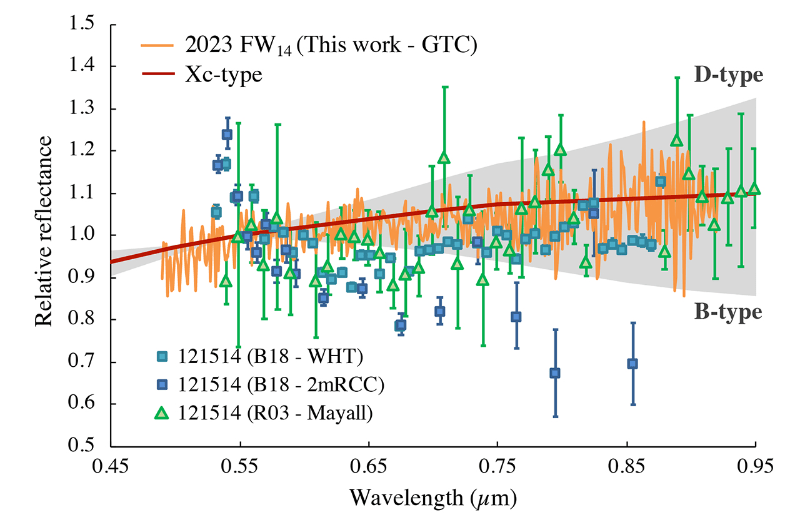Astronomers discovered another asteroid sharing Mars' orbit. These types of asteroids are called trojans, and they orbit in two clumps, one ahead of and one behind the planet. But the origins of the Mars trojans are unclear.
Can this new discovery help explain where they came from?
There are now 14 known Mars Trojans and the name of the newest one is 2023 FW14. They're in two groups, one 60 degrees ahead and one 60 degrees behind Mars. These are the Lagrange 4 and Lagrange 5 points.
Most of the Mars trojans are at the L5 point, and this newly discovered one is the second one found at the L4 point.
New research published in the journal Astronomy and Astrophysics presents the discovery. Its title is " Dynamics of 2023 FW14, the second L4 Mars trojan, and a physical characterization using the 10.4 m Gran Telescopio Canarias." The lead author is Raul de la Fuente Marcos from the Earth Physics and Astrophysics Department at the Universidad Complutense de Madrid.
Scientists aren't certain where the Mars trojans came from. Other trojans like the Jupiter trojans may have been captured by Jupiter in the Solar System's early years. Or Jupiter may have captured them later when it migrated.
But Mars is a much less massive planet, and astronomers aren't certain if Mars can capture trojans the same way Jupiter does. The Mars trojans could be as old as the Jupiter trojans, but some evidence suggests otherwise. The dozen or more trojans at the Mars L5 point seem to be a family from the same collision. The family is called Eureka, and their spectra indicate an olivine-rich composition.
Olivine is relatively rare in the main asteroid belt. That's led some researchers to suggest that the L5 Mars trojans are debris from an ancient impact between Mars, where olivine is common, and a planetesimal.
The two L4 Mars trojans are different. They don't have the same spectra as the L5 trojans, but the pair do show some similarities in their spectra, so a common origin for these two is a possibility.
In this paper, the researchers set out to determine 2023 FW14's origins. They used the Gran Telescopio Canarias for their work. It's a 10.4-meter telescope in Spain's Canary Islands with an attached instrument called the OSIRIS camera spectrograph.
2023 FW14's spectrum places it in the same class as an Xc-type asteroid. The X-type name contains several different types of asteroids with similar spectra but probably with different compositions. Xc-types are a sub-class of the X-types that are intermediate between C-type asteroids, the most common type of asteroid in the Solar System, and the uncommon K-type asteroids.
The researchers also used N-body simulations to try to understand the new asteroid's resonance with Mars. Trojans follow what are known as tadpole orbits. Tadpole orbits are influenced by Earth's gravity, which causes objects to librate or accelerate or decelerate alternately.
Tadpole orbits are complex. Asteroids on these orbits exchange large amounts of energy and angular momentum with a planet moving in a circular orbit. Tadpole loops are made of multiple overlapping epicyclic loops.
This video illustrates the tadpole orbit followed by an asteroid in Jupiter's L4, not Mars' L4, but the concept is the same.2023 FW14 has a higher orbital eccentricity and lower inclination than Mars' other L4 trojan. This means that it occupies an unstable region and orbits at the whim of several different resonances. That instability means that in a few million years, it'll likely be ejected.
The researchers calculated its size as approximately 318 metres (+493/-199.) That makes it one of the smallest known trojans so far.
As for its origins, the authors say that there are two possibilities.
Its long-term behaviour, including its past, suggests that it was captured from the Near Earth Asteroid (NEA) population of Mars-crossing asteroids. But it could be a fragment of another trojan, as well, one that is so far undiscovered, or one that is no longer a trojan.
Spectral data suggests something else. Both of the L4 asteroids appear to be more primitive than Mars' L5 trojans. 2023 FW14's spectrum also supports the idea that it's a captured Mars-crossing NEA. However, that data isn't as clear, according to the authors, and can't be used to rule out the other hypothesis, which is that the asteroid formed in situ. "Although incomplete, the data support the interpretation of 2023 FW14 as an interloper captured from the Mars-crossing NEA population, but they cannot be used to reject the competing hypothesis that 2023 FW14 was produced in situ," they write.
Whatever its origins are, the researchers calculate that 2023 FW14 has about 10 million years before it's ejected from its trojan orbit. It's a temporary trojan, and this discovery could prove that Mars trojans can be temporarily captured, something that so far has been unproven.
 Universe Today
Universe Today

